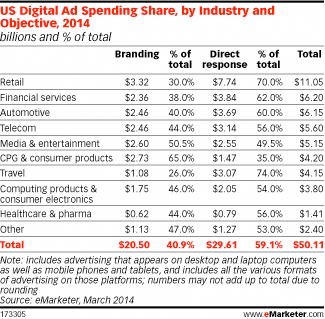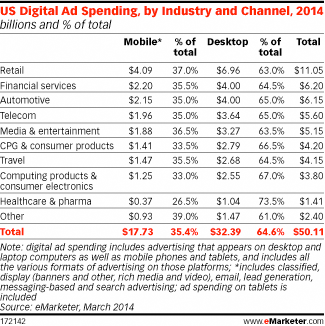Direct-Response Tactics Take Majority of US Marketers’ Budgets
May 21, 2014
![]() US advertisers will collectively spend upward of $50 billion on digital advertising in 2014, according to new figures from eMarketer. This represents the fifth year in a row of torrid growth, reflecting broad economic and advertising industry trends that have driven nonstop, double-digit gains across virtually all industries since the trough of the Great Recession in 2009.
US advertisers will collectively spend upward of $50 billion on digital advertising in 2014, according to new figures from eMarketer. This represents the fifth year in a row of torrid growth, reflecting broad economic and advertising industry trends that have driven nonstop, double-digit gains across virtually all industries since the trough of the Great Recession in 2009.
 But the sweeping story of overall digital ad spending growth can overshadow important subtrends within individual industries. That is the impetus for eMarketer’s new report series, “2014 Digital Ad Spending Benchmarks by Industry,” which provides a comprehensive overview of ad spending with deep-dive information about the challenges and opportunities that are driving marketing decisions in nine sectors: automotive, computing products and consumer electronics, consumer packaged goods (CPG) and consumer products, financial services, healthcare and pharmaceutical, media and entertainment, retail, telecom, and travel.
But the sweeping story of overall digital ad spending growth can overshadow important subtrends within individual industries. That is the impetus for eMarketer’s new report series, “2014 Digital Ad Spending Benchmarks by Industry,” which provides a comprehensive overview of ad spending with deep-dive information about the challenges and opportunities that are driving marketing decisions in nine sectors: automotive, computing products and consumer electronics, consumer packaged goods (CPG) and consumer products, financial services, healthcare and pharmaceutical, media and entertainment, retail, telecom, and travel.
 eMarketer’s ad spending report series breaks down digital spending by objective—direct response vs. branding—to reflect the nuances across industries. At a market level, both direct-response and brand advertising grew at approximately the same pace year over year, just over 16%. However, direct-response advertising increased from a higher base, and it gained $4.74 billion against $2.79 billion for branding objectives, leading to an increase in ad spending market share from 58.4% to 59.1%.
eMarketer’s ad spending report series breaks down digital spending by objective—direct response vs. branding—to reflect the nuances across industries. At a market level, both direct-response and brand advertising grew at approximately the same pace year over year, just over 16%. However, direct-response advertising increased from a higher base, and it gained $4.74 billion against $2.79 billion for branding objectives, leading to an increase in ad spending market share from 58.4% to 59.1%.
At a more granular level, there’s much wider variation when it comes to objectives than there is in the mobile-desktop split. The travel industry—dominated by big online agencies such as Priceline.com and Expedia—tilts heavily to direct response, and specifically search, devoting a larger share of its digital budget to performance advertising than any other industry—74.0%, in fact. At the other end of the spectrum, the CPG and consumer products industry—where only a tiny percentage of total ad buying is done via digital channels—is the most heavily invested in branding efforts, with 65.0% of its total digital ad budget dedicated to that objective.
As marketers get better at measurement and attribution, the lines between direct-response spending and branding are blurring more than ever. In fact, eMarketer adjusted our methodology this year, no longer defining direct-response and branding-focused advertisements based on specific digital ad formats (search vs. display, for instance). eMarketer now bases our definitions of branding and direct response on a marketer’s primary advertising objective rather than the specific way the advertising is priced, measured or formatted. Branding-focused advertising is defined as having the objective of building awareness, familiarity, opinion, consideration or engagement with a brand. It is not designed primarily to drive immediate sales or leads. Direct-response advertising is designed to elicit a specific call to action that prompts a target audience to respond immediately and directly to an advertiser. Both branding-focused and direct-response advertising can take different formats and be priced in various ways.
In addition, new in this year’s reports are eMarketer’s first-ever estimates of mobile vs. desktop spending on an industry-by-industry basis. eMarketer’s analysis found that mobile spending levels were roughly similar across industries, with virtually all sectors committing about one-third of spending to the mobile channel, but there were variations by industry. Retail, which was an early adopter of online advertising, appears to be taking a similarly aggressive path with mobile: The industry commits a larger share of digital dollars to mobile than any other sector.
eMarketer bases all of our forecasts on a multipronged approach that focuses on both worldwide and local trends in the economy, technology and population, along with company-, product-, country- and demographic-specific trends, and trends in specific consumer behaviors. We analyze quantitative and qualitative data from a variety of research firms, government agencies, media outlets and company reports, weighting each piece of information based on methodology and soundness.
In addition, every element of each eMarketer forecast fits within the larger matrix of all our forecasts, with the same assumptions and general framework used to project figures in a wide variety of areas. Regular re-evaluation of each forecast means those assumptions and framework are constantly updated to reflect new market developments and other trends.
Courtesy of eMarketer




























